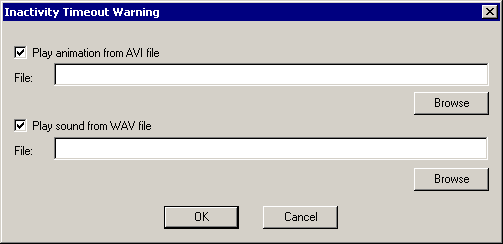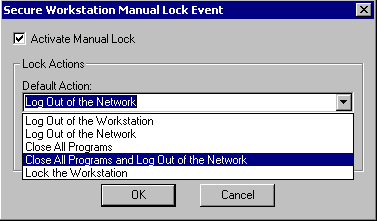Configuring Secure Workstation Events
This section provides information on the following:
- Configuring an Inactivity Timeout Event.
- Configuring a Device Removal Event.
- Configuring a Network Logout Event.
- Configuring the Manual Lock Event.
Configuring an Inactivity Timeout Event
The following figure illustrates the dialog box for configuring Inactivity Timeout events.
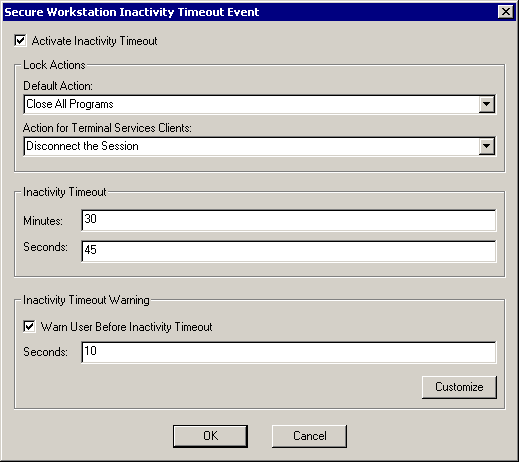
This dialog box enables you to specify the inactivity timeout and configure a warning that is displayed just before the inactivity timeout is reached.
You can configure a .wav file that will be played when the warning is shown. You can also specify an .avi file to be played for the warning. To configure these features:
The warning message can accommodate .avi files that display images of any size.
The warning dialog box is displayed for the last few seconds of the inactivity timeout. You can specify the number of seconds that the warning dialog box is displayed. For example, if you set an inactivity timeout of thirty seconds and configure the warning dialog box to display for ten seconds, Secure Workstation displays the warning dialog box after twenty seconds of inactivity.
Configuring a Device Removal Event
The following figure illustrates the dialog box for a configuring a Device Removal event.
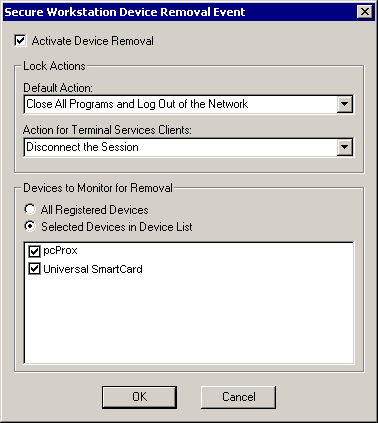
The list under Devices to Monitor for Removal contains a list of devices that are registered with Secure Workstation.
This dialog box enables you to specify which devices are included in the policy. If a device is included in the policy, it must be present during the user's session. If a device in the list is not present, Secure Workstation executes the lock action.
For SecureLogin 3.51.2, both the Universal Smart Card and pcProx Methods for NMAS can report device removal events to Secure Workstation.
Other NMAS partners have also implemented devices that can report device removal events to Secure Workstation. If you want to use a device that does not show up in the list, make sure that you have installed the NMAS Login Client Method for the device. If the device still doesn't show up, check with the vendor of the device to ensure that it will work with Secure Workstation.
Configuring a Network Logout Event
The following figure illustrates a Network Logout event:
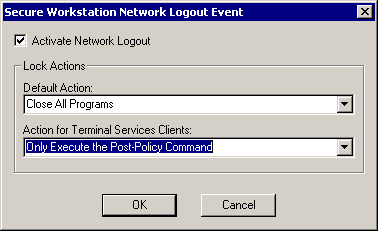
A Network Logout event is triggered when a user logs out of the network. This event could be triggered by either Client32 or the LDAP Authentication Client, depending on which client is present.
One of the intended uses of the Network Logout event is to close programs that the user might have used for single sign-on through Novell SecureLogin. This event might also be used to display a login dialog box or run a script when the user logs out. For more information, see The Post-Policy Command .
This event has a different set of lock actions than the other events. The Default Action list contains the following actions:
- Log Out of the Workstation
- Close All Programs
- Only Execute the Post-Policy Command
The Action for Terminal Services Clients list contains the following actions:
- Log Out of the Workstation
- Close All Programs
- Disconnect the Session
- Only Execute the Post-Policy Command
The Default Action list doesn't include the following actions:
- Lock the Workstation
This action has been omitted because of the behavior of the GINA. If a network connection isn't present when the workstation is locked, the Client32 GINA won't allow the workstation to be unlocked with an eDirectory authentication.
- Log Out of the Network
This action has been omitted because it doesn't make sense to log out of the network in response to a network logout event.
The Network Logout event is the only event that includes the Only Execute the Post-Policy Command action. This action is actually a substitute for the Log Out of the Network action that is available with other events. If you want to execute a Post-Policy Command on network logout, but not do anything else, use this action.
You can use the Post-Policy Command to display a login dialog box or run a script. For more information, see The Post-Policy Command .
Configuring the Manual Lock Event
The Manual Lock event gives users the ability to manually trigger Secure Workstation. A user can manually trigger Secure Workstation either by clicking the Logoff button on the Quick Logon/Logoff Interface or by executing SWLock.exe in the System32 directory.
The following figure illustrates the Manual Lock dialog box.
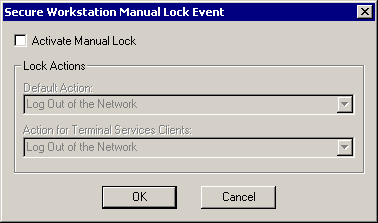
To configure Manual Lock:
